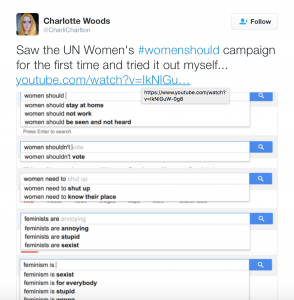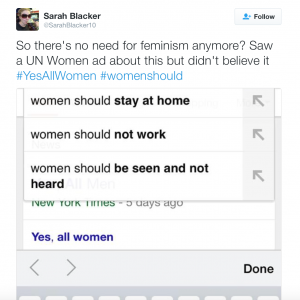Unveiling Gender Inequality: The Autocomplete Truth - UN Women
- Thư Nguyễn Anh
- Jul 13, 2023
- 3 min read
"The Autocomplete Truth" is a globally recognized and successful campaign that focuses on gender equality. Created by the agency Memac Ogilvy & Mather Dubai for the United Nations Women, this campaign utilizes inconvenient truths revealed through internet search behavior to shed light on gender equality issues.
Context
Gender equality is a significant global social issue, which is of particular interest to the international community. Achieving true gender equality in all aspects of social life contributes to justice, social progress, and sustainable development. The United Nations Women has been actively organizing social campaigns to advocate for gender equality for many years. One of their highly successful and widely recognized campaigns is "The Autocomplete Truth," executed by Memac Ogilvy & Mather Dubai and officially launched on March 9, 2013.
Objective
The United Nations Women commissioned Memac Ogilvy & Mather Dubai to develop a creative campaign that would expose the truth about gender equality, generate widespread awareness, and consequently change people's perceptions and actions regarding gender equality on a global scale.
Insight
During the research process to develop this campaign, Art Director Christopher Hunt discovered through Google's "auto-populate" feature that users' search behavior reflected highly negative terms related to women, such as "Women shouldn't...," "Women cannot...," and "Women need to...". These search results, initially assumed to be creative directions of a social campaign, were actually inconvenient truths reflecting the real search behavior of internet users. This insight uncovers the prevalent stereotypes and biases surrounding gender equality.
Strategy
Google, as a search engine, plays a crucial role in modern society, permeating people's daily lives and work. Its strength lies in data. Google collects and filters user search queries, creating a platform to expose what users are genuinely interested in. This data-driven platform provides an ideal opportunity to amplify a global social campaign. Memac Ogilvy & Mather Dubai decided to leverage Google's "autocomplete suggestions" creatively to share the story of gender equality with the world.
Creative Idea: "The Autocomplete Truth"
Execution
Print Ads
The campaign narrative is communicated through a series of creative print ads featuring close-up photographs of women from various countries with Google search suggestions displayed over their mouths, mirroring the autocomplete effect. The search suggestions convey messages that highlight the reality and call for a change in people's perceptions and actions regarding gender equality. These seemingly simple messages have a significant impact on the community.

Viral Clip
A video clip showcasing "The Autocomplete Truth" campaign is released to create a viral effect, increasing campaign awareness and reach.
Social Media
The campaign encourages engagement through popular digital tools like hashtags. People can join the conversation on social media platforms like Twitter using the hashtag #womenshould or visit the United Nations Women website (http://www.unwomen.org/) to discuss social issues related to gender equality.
Results
"The Autocomplete Truth" campaign garnered over 116,000 shares on Facebook and became the most shared topic of the year on Adweek.com. It also gained strong attention from hundreds of blogs, news outlets, and social media platforms worldwide. The campaign was officially launched in early 2013 in the United Arab Emirates and achieved extensive global reach.
Conclusion
Although, there is still a lot of skepticism about the success on a global scale in immediately changing people's perceptions and actions on the issue of gender equality, it is fair to say "The Autocomplete Truth" is indeed a successful, meaningful social campaign by the World Federation of Women and at least the campaign has created enormous awareness of the issue around the world.












Comments